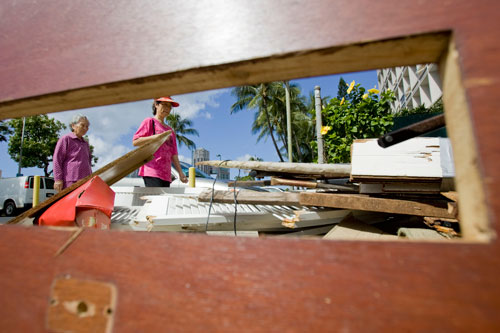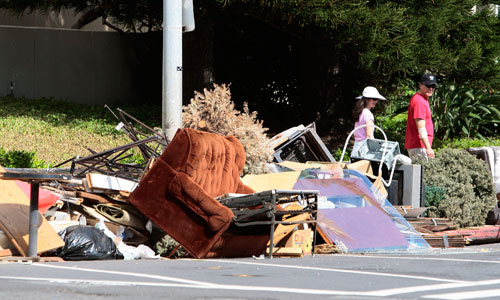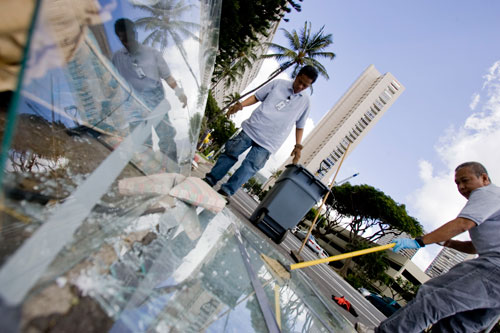Trash accumulates with landfill closed

Since the closure of the Waimanalo Gulch Landfill last week, bulky trash items have started to pile up along sidewalks throughout Oahu. Pedestrians walked around a mound of discarded lumber and other trash Saturday on Kamoku Street in Moiliili.?

An old recliner, crowded the sidewalk on Kamoku Street in Moiliili Saturday along with other discarded furniture, carpeting and cardboard.

Ala Wai Plaza maintenance workers Robert Orsino, right, and Joel Secretaria cleaned up broken glass from a discarded window on the same street.



City Council members Stanley Chang and Tulsi Gabbard Tamayo hope to get answers this morning on how to prevent future disasters at the city’s only landfill like the Jan. 13 release of unknown amounts of medical waste onto Oahu’s Leeward beaches.
But with the Waimanalo Gulch Landfill closed and bulky trash piling up on Oahu sidewalks as a result, today’s Council committee hearings on the spill of medical waste will likely touch on the even trickier issue of what to do about the island’s ongoing problem of mounting trash.
Tamayo, vice president of the Healthy Hawaii Coalition, has spent every day along the Leeward Coast since the Jan. 13 spill, talking to volunteer cleanup crews and listening to their concerns.
"Our goal right now is to make sure that something like this doesn’t happen again," Tamayo said yesterday. "In doing so, hopefully we’ll get a lot of answers to a lot of questions. The future of the landfill is not the purpose of the hearing, but I know those discussions will come."
While residents across Oahu have seen larger-than-normal mounds of bulky trash building up since the landfill was closed following the Jan. 13 storm, Chang also worries about the unseen tons of ash from the HPOWER plant and sludge from the city’s sewage treatment plants that cannot be disposed of because Waimanalo Gulch is closed.
"Without a place for sewage treatment sludge and HPOWER ash, we can’t process waste," Chang said yesterday. "What this disaster has made clear is that without a landfill we’re only a couple of weeks away from really, really big disasters with really, really large effects."
Don't miss out on what's happening!
Stay in touch with breaking news, as it happens, conveniently in your email inbox. It's FREE!
Officials with Waste Management of Hawaii, which operates the Waimanalo Gulch Landfill, declined to be interviewed yesterday.
In an Island Voices essay that appeared in yesterday’s Honolulu Star-Advertiser, Waste Management General Manager Joe Whelan wrote that the landfill was already saturated by two back-to-back rainstorms before the "100-year storm" hit on Jan. 13.
In less than 12 hours, Whelan wrote, 11 inches of rain — or an estimated 200 million gallons of water — fell in the landfill area, leading to the release of medical waste.
No medical waste has been found on the Leeward coast since Thursday, Janice Okubo, spokeswoman for the state Department of Health, said yesterday.
And there have been no reports of anyone becoming ill from the medical waste — or being injured from syringes or other items.
But cleanup crews told Tamayo that a few syringes washed up on smaller beaches around Maili Beach Park on Saturday.
"No one wants to create any kind of hysteria or crazy situation, but we really need to look at this very, very carefully from every angle," Tamayo said. "We need answers to make sure this doesn’t happen again."
Waste Management will be responsible for the unknown cost of the cleanup, Okubo said. "They’re the responsible party and they’re responsible for the cleanup," she said.
Cleanup crews have collected 52 40-gallon garbage bags of debris since the Jan. 13 storm, Okubo said, but only "a small percentage of that was medical debris. The majority was assorted plastics."
Yesterday the state Health Department — in consultation with officials from the city and U.S. Environmental Protection Agency — removed "contaminated water" warning signs from Kahe Point to the Ko Olina Lagoons that went up after the Jan. 13 spill.
But Okubo warned beachgoers to be alert for poor water quality.
"Based on the bacterial levels and amount of debris that was found, it’s probably OK for people to go back swimming into the water," she said. "But they should still be cautious if they see brown water. … If water is discolored, people should use common sense and not go back into the water."
Health officials took down the warning signs after daily water samples indicated that bacterial levels had returned to normal, health officials said in a statement.
Ken Williams, executive vice president and resort manager for the Ko Olina Resort, welcomed the reopening of Leeward beaches.
"The whole community wants answers," Williams said yesterday. "This experience has been unfortunate for the whole coastline. It points to the only real long-term solution, which is to close the landfill. We live on the most isolated land mass in the world, and we should be seeking cutting-edge technology. We shouldn’t be following, we should be leading the world in disposal. You’ve got to be hopeful that the decision makers will do the right thing."
He called this morning’s hearing "a step in the right direction."
On the opposite end of the island, Ron Lockwood, chairman of the McCully/Moiliili Neighborhood Board, has seen mattresses piling up outside his condominium building since the landfill closed.
"There are two mattresses sitting out there right now because they were not picked up this week, and they’ll be sitting there until the February pickup, if we do have a pickup then," Lockwood said yesterday. "It’s a huge problem in Makiki. And Kaimuki’s got a bunch of bulky items piling up."
Lockwood plans to attend this morning’s joint hearings by the Council’s Committee on Safety, Economic Development and Governmental Affairs and the Committee on Public Works and Sustainability.
Like others, Lockwood wants an explanation of why medical waste is even allowed at the city’s landfill.
But he also wants answers to the bigger question of how Oahu will dispose of all of its trash.
"We’ve already tried shipping it off island, and that didn’t work," Lockwood said. "I’d like to hear an open and honest discussion of where we go from this point."




